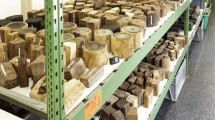Abstract
Most of the environmental specifications to preserve valuable collections assume hygrothermal equilibrium of the object with the surrounding environment. Though the assumption is valid for most of museum interiors, it does not reflect climate conditions in historic houses and churches whose specificity lies in dynamic temperature and relative humidity (RH) variations, particularly intense in cases of operating heating systems. The present paper analyses the risk of fracture in massive wooden cultural heritage objects, particularly endangered by gradients of moisture forming in their volume due to dynamic environmental variations. The study aimed at elucidating general trends as both crack formation and propagation depend on material parameters of a specific wooden element, which can vary even within the same wood species. A two-dimensional elastic model of a massive object made of pine wood was subjected to two types of RH variations: step and sinusoidal. The critical amplitude and duration of variations inducing crack propagation were determined for both variation types. The modelling showed that the risk of fracture was significantly higher for a sinusoidal variation than for a sudden RH drop. Therefore, sinusoidal variations should be considered the worst-case condition when analysing risk of fracture in wooden objects.

















Similar content being viewed by others
References
Aira JR, Arriaga F, Iñiguez-González G (2014) Determination of the elastic constants of Scots pine (Pinus sylvestris L.) wood by means of compression tests. Biosyst Eng 126:12–22
ASHRAE (2019) Museums, galleries, archives and libraries. ASHRAE handbook. Chap 24. American Society of Heating and Air-Conditioning Engineers, Atlanta
Bertolin C, Karvan P, De Rosa A, Javad Razavi SM, Berto F (2021) Relation between fracture characteristics and moisture content along longitudinal direction in a naturally drying Scots pine. Theor Appl Fract Mec. https://doi.org/10.1016/j.tafmec.2021.102911
Bratasz Ł, Kozłowski R, Kozłowska A, Rachwał B (2010) Sorption of moisture and dimensional change of wood species used in historic objects. In: Gril J (ed) Wood science for conservation of cultural heritage—Braga 2008: proceedings of the international conference held by COST Action IE0601. Firenze University Press, Florence, pp 11–16
Bratasz Ł, Kozłowska A, Kozłowski R (2012) Analysis of water adsorption by wood using the Guggenheim–Anderson-de Boer equation. Eur J Wood Prod 70:445–451
Dag S (2006) Thermal fracture analysis of orthotropic functionally graded materials using an equivalent domain integral approach. Eng Fract Mech 73:2802–2828
Danielsson H, Gustafsson PJ (2013) A three dimensional plasticity model for perpendicular to grain cohesive fracture in wood. Eng Fract Mech 98:137–152
Dinwoodie JM (2004) Timber. Its nature and behaviour, 2nd edn. E & FN Spon, London
Dubois F, Chazal C, Petit C (1999) Modelling of crack growth initiation in a linear viscoelastic material. J Theor Appl Mech 37:207–222
Felike T, Zimmer K, Fromm J, Larnøy E (2011) Sorption behaviour of Scots pine in Northern Europe. In: Proceedings of the 7th meeting of the Nordic-Baltic Network in Wood Material Science & Engineering. https://nibio.brage.unit.no/nibio-xmlui/handle/11250/2673119?show=full. Accessed 7 June 2021
Griffith AA (1921) The phenomena of rupture and flow in solids. Philos Trans R Soc A 221:582–293
Gril J, Ravaud E, Uzielli L, Dupré JC, Perre P et al (2006) Mona Lisa saved by the Griffith theory: assessing the crack propagation risk in the wooden support of a panel painting. In: International conference on integrated approach to wood structure, behavior and applications, pp 1–6
Güntekin E, Akar S (2019) Influence of moisture content on elastic constants of Scots Pine wood subjected to compression. Drewno 62(204):41–53
Hamdi SE, Moutou Pitti R, Dubois F (2017) Temperature variation effect on crack growth in orthotropic medium: finite element formulaion for the viscoelastic behavior in thermal cracked wood-based materials. Int J Solids Struc 115–116:1–13
Hamdi SE, Moutou Pitti R (2018) Numerical investigation of climate change impacts on European wood species vulnerability. Procedia Struct Integr 13:523–528
Hein J, Kuna M (2017) A generalized J-integral for thermal shock analyses of 3D surface cracks in spatially and temperature dependent materials. Theor Appl Fract Mec 92:318–330
Irwin G (1957) Analysis of stresses and strains near the end of a crack traversing a plate. J Appl Mech-T ASME 24:361–364
Jakieła S, Bratasz Ł, Kozłowski R (2008) Numerical modelling of moisture movement and related stress field in lime wood subjected to changing climate conditions. Wood Sci Technol 42:21–37
Kossakowski PG (2009) Mixed-mode I/II fracture toughness of pine wood. Arch Civ Eng 55(2):199–227
Luimes RA, Suiker ASJ (2021) Numerical modelling of climate-induced fracture and deformation in wood: application to historical museum objects. Int J Solids Struct 210–211:237–254
Luimes RA, Sukier ASJ, Verhoosel CV, Jorissen AJM, Schellen HL (2018a) Fracture behaviour of historic and new oak wood. Wood Sci Technol 52:1243–1269
Luimes RA, Suiker ASJ, Jorissen AJM, van Duin PHJC, Schellen HL (2018b) Hygro-mechanical response of oak wood cabinet door panels under relative humidity fluctuations. Herit Sci 6:72
Mecklenburg MF (2007) Determining the acceptable ranges of relative humidity and temperatures in museums and galleries, Part 1, Structural response to relative humidity. https://repository.si.edu/handle/10088/7056. Accessed 7 June 2021
Mecklenburg MF, Tumosa CS (1991) An introduction into the mechanical behavior of paintings subjected to changes in temperature and relative humidity. In: Mecklenburg MF (ed) Art in transit: studies in the transport of paintings. National Gallery, Washington, pp 173–214
Mecklenburg MF, Tumosa CS, Erhardt D (1998) Structural response of painted wood surfaces to changes in ambient relative humidity. In: Dorge V, Howlett FC (eds) Painted wood: history and conservation. The Getty Conservation Institute, Los Angeles, pp 464–83
Mualem Y (1974) A conceptual model of hysteresis. Water Resour Res 10:514–520
Pencik J (2015) Modelling of experimental tests of wooden specimens from Scots Pine (Pinus sylvestris) with the help of anisotropic plasticity material model. Drvna Ind 66(1):27–33
Phan NA (2016) Simulation of time-dependent crack propagation in a quasi-brittle material under relative humidity variations based on cohesive zone approach: application to wood. Dissertation, Université de Bordeaux
Porter AW (1964) On the mechanics of fracture in wood. For Prod J 14(2):325–331
Rachwał B, Bratasz Ł, Krzemień L, Łukomski M, Kozłowski R (2012) Fatigue damage of the gesso layer in panel paintings subjected to changing climate conditions. Strain 48:474–481
Repola J (2006) Models for vertical wood density of Scots pine, Norway spruce and birch stems, and their application to determine average wood density. Silva Fenn 40(4):673–685
Rice JR (1968) A path independent integral and the approximate analysis of strain concentration by notches and cracks. J Appl Mech 35:379–386
Schniewind AP, Centeno JC (1973) Fracture toughness and duration of load factor I. Six principal systems of crack propagation and the duration factor for cracks propagating parallel to grain. Wood Fiber 5:152–159
Simpson WT (1993) Determination and use of mosture diffusion coefficient to characterize drying of northern red oak (Quercus-rubra). Wood Sci Technol 27:409–420
Stanzl-Tschegg SE, Tan DM, Tschegg EK (1995) New splitting method for wood fracture characterization. Wood Sci Technol 29:31–50
Time B (1998) Hygroscopic moisture transport in wood. Dissertation, Norwegian University of Science and Technology
Triboulot P, Jodin P, Pluvinage G (1984) Validity of fracture mechanics concepts applied to wood by finite element calculation. Wood Sci Technol 18:51–58
Vasic S, Stanzl-Tschegg S (2007) Experimental and numerical investigation of wood fracture mechanisms at different humidity levels. Holzforschung 61:367–374
Yeh B, Schniewind AP (1992) Elasto-plastic fracture mechanics of wood using the J-integral method. Wood Fiber Sci 24(3):364–376
Yildirim B (2006) An equivalent domain integral method for fracture analysis of functionally graded materials under thermal stresses. J Therm Stresses. https://doi.org/10.1080/01495730500499175
Acknowledgements
The authors are grateful for granting access to the computing infrastructure built in the projects POIG.02.03.00-00-028/08 "PLATON—Science Services Platform" and POIG.02.03.00-00-110/13 "Deploying high-availability, critical services in Metropolitan Area Networks (MAN-HA)".
Funding
This work received funding from the Research Council of Norway in the framework of “SyMBoL–Sustainable Management of Heritage Building in a Long-term Perspective” Project [project no. 274749] as well as from the Polish National Agency for Academic Exchange [Grant PPN/PPO/2018/1/00004/U/00001] and the statutory research fund of the Jerzy Haber Institute of Catalysis and Surface Chemistry, Polish Academy of Sciences.
Author information
Authors and Affiliations
Contributions
LB: Conceptualization of the model, development of methodology, analysis and interpretation of the results, preparing manuscript. MS: Development and validation of the model, performing calculations, data analysis and interpretation, preparing manuscript.
Corresponding author
Ethics declarations
Conflict of interest
The authors declare that they have no known competing financial interests or personal relationships that could have appeared to influence the work reported in this paper.
Additional information
Publisher's Note
Springer Nature remains neutral with regard to jurisdictional claims in published maps and institutional affiliations.
Rights and permissions
About this article
Cite this article
Soboń, M., Bratasz, Ł. A method for risk of fracture analysis in massive wooden cultural heritage objects due to dynamic environmental variations. Eur. J. Wood Prod. 80, 1201–1213 (2022). https://doi.org/10.1007/s00107-022-01841-3
Received:
Accepted:
Published:
Issue Date:
DOI: https://doi.org/10.1007/s00107-022-01841-3




